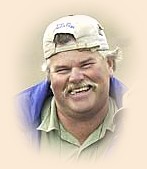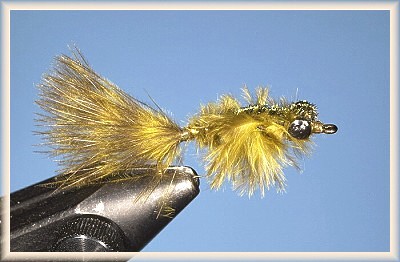The Damsel Marabou Nymph is a popular fly in the
Eastern Sierra used mainly in our many lakes. The
first ones I tied were in the traditional pattern
and while I got some action using them I thought I
could do better. I thought maybe it was my presentation
until one day I watched a real damsel nymph propel
itself by my float tube. It looked "buggier" than
my pattern and it pulsated up and down more than my
retrieval was producing. The increased buggieness
was easy, more marabou. The trick was my fly needed
more weight to imitate that up and down pulsating
motion with my retrievals but the body needs to
remain slender which ruled out weighting the fly.
I had been using plastic black eyes up until it dawned
me to go with the Dazl-eyes for the extra weight. We're
now having lots of fun catching Browns from our tubes
with this variation of the Damsel Nymph! This fly tied
on a size #10.
Materials List: Convict Damsel Nymph
Hook: TMC 200R 10-18.
Thread: Olive 6/0.
Tail: Grizzly Marabou Olive.
Body: Grizzly Marabou Olive.
Rib: Gold Tinsel.
Wing case: Peacock Herl.
Eyes: 3/32 Dazl-eyes Black (w/eye polish).
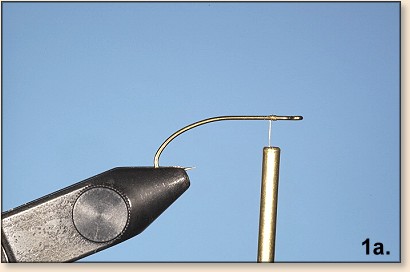
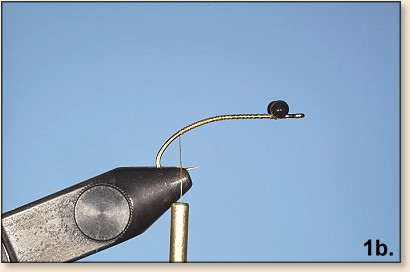

1. The Convict Damsel Nymph starts with the traditional
tie on of the thread. I tie on particularly tight because
right where I tie on is where I attach the Dazl-eyes.
The proportion of the eyes to the size of the fly I
think is important so on sizes 10-12 which is the only
sizes I tie, I use the 3/32 eyes. Attached the eyes
with a figure eight tie and once attached, I put a
drop of head cement on the figure eight. I give the
eyes a little extra depth by using black finger nail
polish and placing a drop on end of the eyes. I put
on 3 coats. You can do this before you actually tie
the eyes on but with their small size, I find it just
as easy to paint them once they are attached to the hook.

2. Selecting the right marabou feather I think is
important. I look for one that's not really "bushy"
but has a narrow profile. The tip of the feather is
going to be the tail and if the feather I have selected
is not bushy enough for the tail, I will add an extra
feather just to the tail.

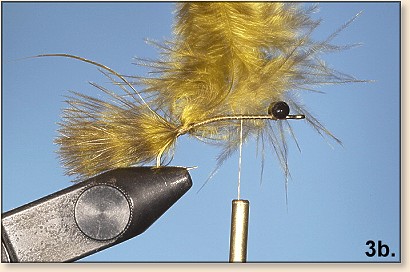
3. Right at the attach point of the marabou, I tie
in the gold tinsel. I prefer the flat tinsel. Once
attached, wrap the thread up the shank approximately
2/3 of the length behind the hook eye.


4. Now comes the only tricky part of tying this fly.
I twist the marabou, twisting it as tight as I can to
get all the barbs into a single strand. You've got to
be careful you don't twist too tight and break the shaft
of the feather. With it being twisted, I start to wrap
the feather around the hook. As I wrap, I keep on
twisting making sure I gather in as many barb of the
feather as I can. Once the wrap is to the thread, tie
off the feather.
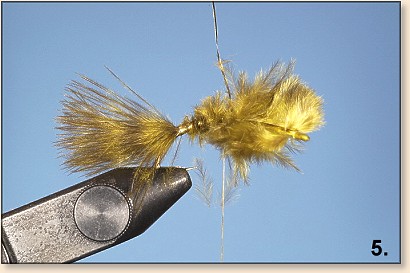
5. Wrap the tinsel up to the tie off point of the
marabou. Take care as you wrap the tinsel to gather
in still any loose barbs of marabou. Ideally we want
as slender a body profile as we can produce. Tie
off and trim.

6. Hard to see in all of that marabou, but tie in
the Peacock Herl. I use 5-6 strands of herl to create
a bulky wing case and our trout just seem to love Herl.
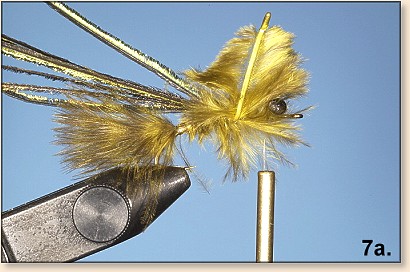
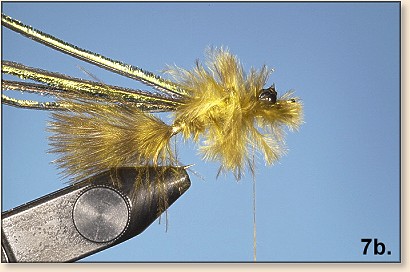
7. It's back to the marabou. Proceed to wrap up the
rest of the hook shank with the marabou. The one
difference is we don't need to twist the marabou,
bushy is a good thing as we're now wanting to imitate
legs. Tie off the marabou right behind the Dazl-eyes.
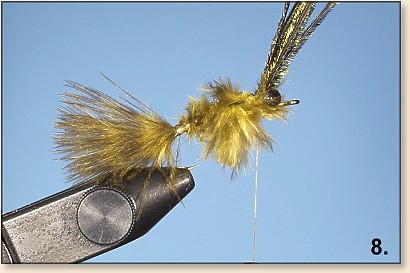
8. Bring the Peacock Herl forward and tie it down
right behind the Dazly eyes. Smooth the marabou down
the best you can on the top of the hook shank to make
a bed for the herl. Wrap it down with just a couple
of wraps and advance the thread to the front of the
Dazl-eyes.
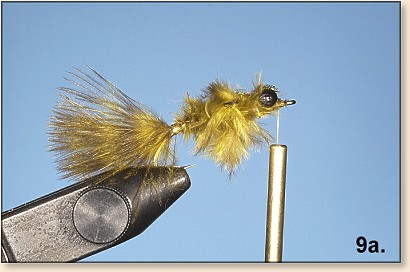
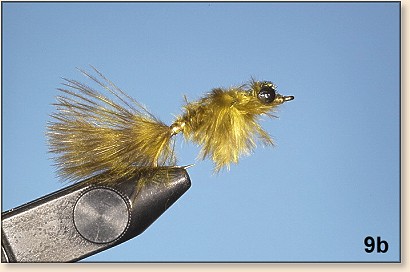
9. Bring the Herl over the Dazl-eyes and tie it off.
Wrap the thread to form a head creating a classic head
and tie off. ~ Moose
Photographic note:
Photos captured by D1H, 60f2.8AF micro with SB-29s flash on Lexar digital film.
About Moose:
